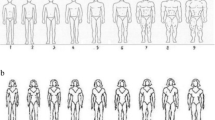Abstract
A grounded theory study was undertaken to describe how adolescents make decisions about sunbathing during the transition from childhood to adolescence and to propose an explanation for the relationships among factors affecting the adoption of sun tanning. In-depth interviews (n = 40) were conducted separately with adolescents (aged 12 to 16 years) and their parents. Constant comparative analysis of adolescents’ accounts identified two methods that adolescents described as a means of getting a suntan: intentional sun tanning and incidental sun tanning. The process of adolescents’ decision-making about getting a suntan can be understood by examining the following sequence: becoming motivated to get a tan, experimenting with sun tanning, and establishing self as an intentional tanner or incidental tanner. Implications for developing strategies to prevent the adoption of sun-tanning habits among adolescents are presented.
Similar content being viewed by others
References
Brandberg, Y., Ullen, H., Sjoberg, L., & Holm, L. E. (1998). Sunbathing and sunbed use related to self-image in a randomized sample of Swedish adolescents. European Journal Cancer Prevention, 7, 321–329.
Broadstock, M., Borland, R., & Gason, R. (1992). Attractiveness by adolescents. Journal of Applied Social Psychology, 22, 157–172.
Castle, C. M., Skinner, T. C., & Hampson, S. E. (2000). Young women and suntanning: An evaluation of a heath education leaflet. Psychology & Health, 14, 517–527.
Clandinin, D. J., & Connelly, F. M. (1998). Personal experience methods. In N. K. Denzin & Y. S. Lincoln (Eds.), Collecting and interpreting qualitative materials (pp. 150–178). Thousand Oaks, CA: Sage.
Cockburn, J., Hennrikus, D., Scott, R., & Sanson-Fisher, R. (1989). Adolescent use of sun-protection measures. The Medical Journal of Australia, 151, 136–140.
Gallagher, R. P., McLean, D. I., Yang, C. P., Coldman, A. J., Silver, H. K., & Spinelli, J. J. (1990). Suntan, sunburn, and pigmentation factors and the frequency of acquired melanocytic nevi in children. Similarities to melanoma: the Vancouver Mole Study. Arch Dermatol, 126, 770–776.
George, P. M., Kuskowski, M., & Schmidt, C. (1996). Trends in photoprotection in American fashion magazines, 1983–1993. Journal of the American Academy of Dermatology, 34, 424–428.
Gibbons, L., & Anderson, L. (1992). Proceedings of the symposium on ultraviolet radiation-related diseases. Chronic Disease in Canada, 13, s1-s42.
Glaser, B., & Strauss, A. (1967). The discovery of grounded theory. Chicago: Aldine.
Hillhouse, J., & Turrisi, R. (2002). Examination of the efficacy of an appearance-focused intervention to reduce UV exposure. Journal of Behavioral Medicine, 25, 395–408.
Hillhouse, J., Turrisi, R., & Kastner, M. (2000). Modeling tanning salon behavioral tendencies using appearance motivation, self-monitoring and the Theory of planned behavior. Health Education Research, 15, 405–414.
Jones, J. L., & Leary, M. R. (1994). Effects of appearance-based admonitions against sun exposure and tanning intentions in young adults. Health Psychology, 13, 86–90.
Keesling, B., & Friedman, H. S. (1987). Psychosocial factors in sunbathing and sunscreen use. Health Psychology, 6, 477–493.
Leary, M. R., Tchividijan, L. R., & Kraxberger, B. E. (1994). Self-presentation can be hazardous to your health: Impression management and health risk. Health Psychology, 13, 461–470.
Livingston, P. M., White, V. M., Ugoni, A. M., & Borland, R. (2001). Knowledge, attitudes and self-care practices related to sun protection among secondary students in Australia. Health Education Research, 16, 269–278.
Lovato, C. Y., Shoveller, J. A., Peters, L., & Rivers, J. K. (1998a). Canadian National Survey on Sun Exposure & Protective Behaviours: Youth at Leisure. Cancer Prevention & Control, 2, 117–122.
Lovato, C. Y., Shoveller, J. A., Peters, L., & Rivers, J. K. (1998b). Canadian National Survey on Sun Exposure & Protective Behaviours: Parent Reports of Children. Cancer Prevention & Control, 2, 123–128.
Lowe, J. B., Balanda, K. P., & Gillespie, A. M. (1993). Sun-related attitudes and beliefs among Queensland school children: The role of gender and age. Australian Journal of Public Health, 17(3), 202–208.
Lupton, D., & Gaffney, D. (1996). Discourses and practices related to suntanning and solar protection among young Australians. Health Education Research, 11, 147–159.
Melia, J., & Bulman, A. (1995). Sunburn and tanning in a British population. Journal of Public Health Medicine, 17, 223–229.
Miller, A. G., Ashton, W. A., McHoskey, J. W., & Gimbel, J. (1990). What price attractiveness? Stereotype and risk factors in suntanning behavior. Journal of Applied Social Psychology, 20, 1272–1300.
National Cancer Institute of Canada. (2001). Canadian Cancer Statistics for 2001. Toronto, Canada: Author.
Newman, W., & Agro, A. D. (1996). A survey of recreational sun exposure of residents of San Diego, California. American Journal of Preventive Medicine, 12, 186–193.
Oliphant, J. A., Forster, J. L., & McBride, C. M. (1994). The use of commercial tanning facilities by suburban Minnesota adolescents. American Journal of Public Health, 84, 476–478.
Richards, R., McGee, R., & Knight, R. G. (2001, May). Sun protection practices, knowledge and attitudes to tans among New Zealand adolescents, 1991–1997. New Zealand Medical Journal, 229–231.
Rosso, S., Zanetti, R., Martinez, C., Tormo, M. J., Schraub, S., & Sancho-Garnier, H. (1996). The multicentre south European study “Helios.” II: Different sun exposure patterns in the aetiology of basal cell and squamous cell carcinomas of the skin. British Journal of Cancer, 73, 1447–1454.
Strauss, A., & Corbin, J. (1998). Basics of qualitative research: Techniques and procedures for developing grounded theory (2nd ed.). Thousand Oaks, CA: Sage.
Wichstrom, L. (1994). Predictors of Norwegian adolescents’ sunbathing and use of sunscreen. Health Psychology, 13, 412–420.
Young, R. A., Valach, L., Dillabough, J., Dover, C., & Matthes, G. (1994). Career research from an action perspective: The self-confrontation procedure. Career Development Quarterly, 43, 185–196.
Author information
Authors and Affiliations
Corresponding author
Rights and permissions
About this article
Cite this article
Shoveller, J.A., Lovato, C.Y., Young, R.A. et al. Exploring the development of sun-tanning behavior: A grounded theory study of adolescents’ decision-making experiences with becoming a sun tanner. Int. J. Behav. Med. 10, 299–314 (2003). https://doi.org/10.1207/S15327558IJBM1004_2
Issue Date:
DOI: https://doi.org/10.1207/S15327558IJBM1004_2




